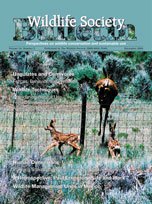I assessed the ability of dog–handler teams to recover dead bats (Chiroptera) during fatality searches typically performed at wind energy facilities to determine fatality rates for birds and bats. I conducted this study at the Mountaineer and Meyersdale Wind Energy Centers in West Virginia and Pennsylvania, USA, respectively. Dogs found 71% of bats used during searcher-efficiency trials at Mountaineer and 81% of those at Meyersdale, compared to 42% and 14% for human searchers, respectively. Dogs and humans both found a high proportion of trial bats within 10 m of the turbine, usually on open ground (88% and 75%, respectively). During a 6-day fatality search trial at 5 turbines at Meyersdale, the dog–handler teams found 45 bat carcasses, of which only 42% (n = 19) were found during the same period by humans. In both trials humans found fewer carcasses as vegetation height and density increased, while dog–handler teams search efficiency remained high. Recommendations for evaluating the biases and efficiency when using dogs for bat fatality searches are provided.
How to translate text using browser tools
1 December 2006
A Preliminary Evaluation on the Use of Dogs to Recover Bat Fatalities at Wind Energy Facilities
EDWARD B. ARNETT
ACCESS THE FULL ARTICLE
It is not available for individual sale.
This article is only available to subscribers.
It is not available for individual sale.
It is not available for individual sale.

Wildlife Society Bulletin
Vol. 34 • No. 5
December 2006
Vol. 34 • No. 5
December 2006
bats
Chiroptera
fatality searches
Pennsylvania
West Virginia
Wind turbines




